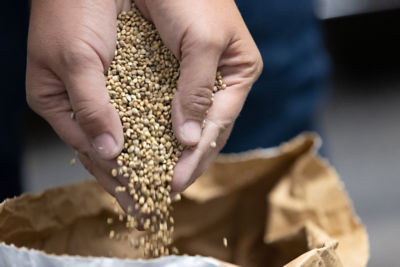Causal Agent
Sclerotium rolfsii (teleomorph: Athelia rolfsii)
Distribution
Worldwide
Symptoms
Southern blight is commonly observed on cantaloupe, squash and watermelon. The first symptom of the disease is a mid-day wilting of the plant. Leaves turn yellow and within a few days the plant collapses leading to plant death. The rapid collapse of the plant is due to girdling of the stem at the soil surface, and the entire root system is often completely rotted. The fungus develops a white mycelium, which may be fan shaped, over the surface of the stem. Light brown bodies (sclerotia) may be observed embedded within the white mycelium. These sclerotia turn dark brown with age. The fungus also infects fruit in contact with infested soil, developing sunken, yellow spots which decay and collapse. Large amounts of white mycelium and sclerotia can form on the fruit as it decays.
 Melon stem infected with Sclerotium rolfsii. Note the small spherical tan-to-brown sclerotia forming on and within the white mycelia. (Courtesy of Tom Isakeit)
Melon stem infected with Sclerotium rolfsii. Note the small spherical tan-to-brown sclerotia forming on and within the white mycelia. (Courtesy of Tom Isakeit)
Conditions for Development
Sclerotia, which are the overwintering structure, allow Sclerotium rolfsii to survive for many years in the soil. Sclerotia are spread by movement of soil or by surface water. The disease is favored by high temperatures [27–32ºC (80–90ºF)] and high soil moisture.
Control
A good sanitation program is generally the most effective control measure. Remove and burn infected plants to prevent inoculum build-up. Deep plow crop residue to reduce inoculum levels. Rotate to non-host crops (corn and small grains) for a period of three to five years. Good water management can help reduce soil moisture, which in turn reduces the amount of germinating sclerotia in the soil. Fumigation can also provide control. Some fungicides have proved effective in controlling this disease.



